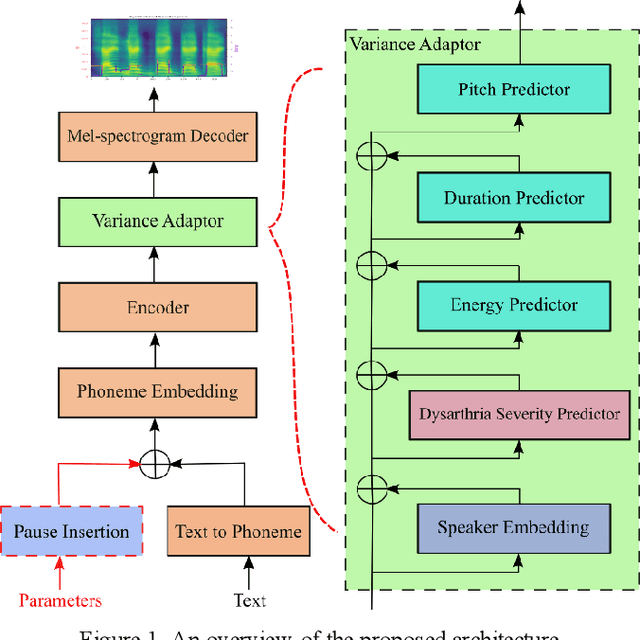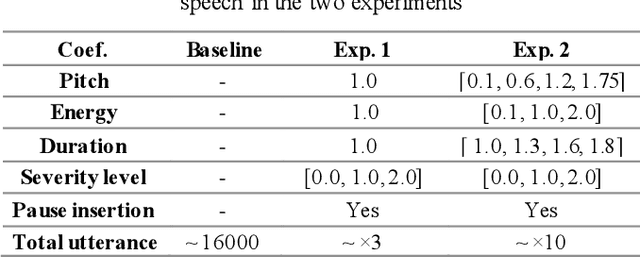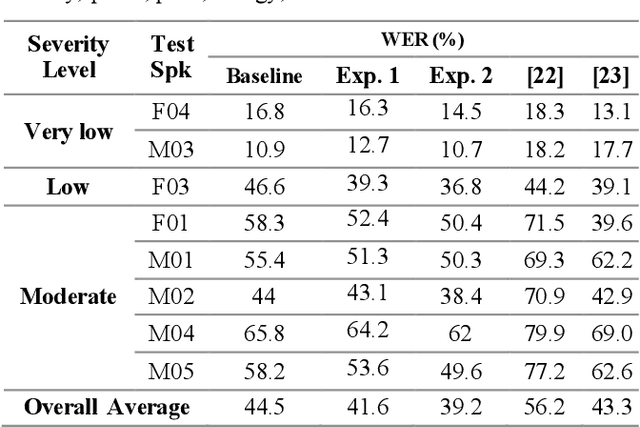Jeffrey Berry
Accurate synthesis of Dysarthric Speech for ASR data augmentation
Aug 16, 2023Abstract:Dysarthria is a motor speech disorder often characterized by reduced speech intelligibility through slow, uncoordinated control of speech production muscles. Automatic Speech recognition (ASR) systems can help dysarthric talkers communicate more effectively. However, robust dysarthria-specific ASR requires a significant amount of training speech, which is not readily available for dysarthric talkers. This paper presents a new dysarthric speech synthesis method for the purpose of ASR training data augmentation. Differences in prosodic and acoustic characteristics of dysarthric spontaneous speech at varying severity levels are important components for dysarthric speech modeling, synthesis, and augmentation. For dysarthric speech synthesis, a modified neural multi-talker TTS is implemented by adding a dysarthria severity level coefficient and a pause insertion model to synthesize dysarthric speech for varying severity levels. To evaluate the effectiveness for synthesis of training data for ASR, dysarthria-specific speech recognition was used. Results show that a DNN-HMM model trained on additional synthetic dysarthric speech achieves WER improvement of 12.2% compared to the baseline, and that the addition of the severity level and pause insertion controls decrease WER by 6.5%, showing the effectiveness of adding these parameters. Overall results on the TORGO database demonstrate that using dysarthric synthetic speech to increase the amount of dysarthric-patterned speech for training has significant impact on the dysarthric ASR systems. In addition, we have conducted a subjective evaluation to evaluate the dysarthric-ness and similarity of synthesized speech. Our subjective evaluation shows that the perceived dysartrhic-ness of synthesized speech is similar to that of true dysarthric speech, especially for higher levels of dysarthria
Synthesizing Dysarthric Speech Using Multi-talker TTS for Dysarthric Speech Recognition
Jan 27, 2022



Abstract:Dysarthria is a motor speech disorder often characterized by reduced speech intelligibility through slow, uncoordinated control of speech production muscles. Automatic Speech recognition (ASR) systems may help dysarthric talkers communicate more effectively. To have robust dysarthria-specific ASR, sufficient training speech is required, which is not readily available. Recent advances in Text-To-Speech (TTS) synthesis multi-speaker end-to-end TTS systems suggest the possibility of using synthesis for data augmentation. In this paper, we aim to improve multi-speaker end-to-end TTS systems to synthesize dysarthric speech for improved training of a dysarthria-specific DNN-HMM ASR. In the synthesized speech, we add dysarthria severity level and pause insertion mechanisms to other control parameters such as pitch, energy, and duration. Results show that a DNN-HMM model trained on additional synthetic dysarthric speech achieves WER improvement of 12.2% compared to the baseline, the addition of the severity level and pause insertion controls decrease WER by 6.5%, showing the effectiveness of adding these parameters. Audio samples are available at
 Add to Chrome
Add to Chrome Add to Firefox
Add to Firefox Add to Edge
Add to Edge